�
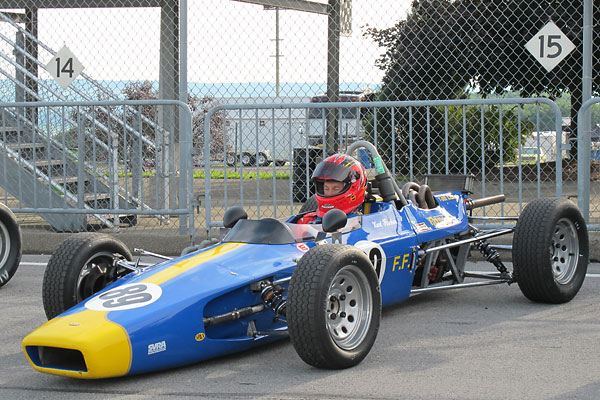
�
Kurt Fischer's 1970 Lola T200 Formula Ford Racecar
� ��
Owner: Kurt Fischer
�
City: Penn Yan, New York
�
Model: 1970 Lola T200
�
Engine: Ford Kent 1600cc
�
Prepared by: GMT Racing�
�
Lola's First Formula Ford
��
Shortly after a new class called "Formula Ford" was announced, a host of constructors brought�
forth new designs for it. Aspiring racers could choose between�
Alexis,�
Caldwell, Dulon,�
Lotus,�
Macon,�
Merlyn,�
Royale, Titan and many other marques. Though the technical differences�
between these cars are fascinating, in truth they're pretty much birds of a feather.�
For example. as a rule first generation Formula Fords featured round-tube frames with engine�
coolant piped through upper longitudinal members to forward-mounted radiators. Nearly all these�
cars featured Triumph Herald front uprights and similar suspension geometry. Wheelbase and track width (i.e.�
the distance between left and right tires, measured at center of road contact area) weren't�
specified by the rules, but first generation Formula Fords were pretty similar in these�
important measurements too. �
�
Lola Cars Limited arrived at the party late, but they brought a distinctively different car�
design. Introduced for 1970, the Lola T200 model featured a robust frame of square tubing.�
Coolant was plumbed separately, not through frame tubes. Front uprights were specially fabricated,�
not off-the-shelf forgings. And most distinctively Lola combined an uncommonly short wheelbase,�
wider than average track, and a relatively low (layed-down) driver position. For a certain kind�
of driver on a certain kind of racetrack, Lola provided what driver Mark Donohue might have�
called "the unfair advantage." (For Mark Donohue's comments on a different short-wheelbase�
1970 Lola model, see our write-up on Lola's T190.)�
�
Lola's T200: shorter wheelbase & wider track than other 1970 models�
| Constructor | Model | Wheelbase | Front Track | Rear Track | ||
| Caldwell | D9B | 90.5 | 52 | 53.5 | ||
| Crosslé | 16F | 90 | 51.25 | 53.5 | ||
| Lola | T200 | 84 | 56 | 56 | ||
| Lotus | 61M | 90 | 51.5 | 51.5 | ||
| March | 709 | 90 | 52 | 52 | ||
| Merlyn | 17 | 90 | 48 | 50.5 | ||
| Royale | RP3 | 93 | 55 | 55 | ||
| Titan | Mk6 | 92.5 | 54 | 53.25 | ||
| Winkleman (Palliser) | WDF2 | 91 | 52 | 54 | ||
�
�
Note: except for the Lola T200 numbers, most of the dimensions above have been excerpted�
from "Charting the Fords" from the May 1979 edition of Racecar magazine. Elden and Tecno models�
may have been even shorter than Lola T200, but have been omitted here for lack of complete/accurate�
dimensions. All the measurements are subject to variation due to suspension adjustment and other�
service issues. For example, wheel substitutions often cause changes in track measurements.�
Our Lola T200 measurements are from Lola's original engineering drawings. They were provided to�
BritishRacecar.com by former Lola Chief Engineer Bob Marston.�
�
The T200's short wheelbase and wide track can be significant competitive advantages on tight�
and twisty racetracks, in making quick transitions, and in taking high-g turns. As in so many�
things, there's an implied compromise. Its shorter wheelbase can make the T200 seem a little�
nervous under heavy braking. Brake bias must be adjusted carefully: the car isn't forgiving�
if bias is set too far rearward. The T200's wider track slightly increases aerodynamic drag�
but on the other hand the low driver position somewhat offsets that. �
�
With only modest alterations the Lola Formula Ford model was continued in 1971 as the T202�
and then in 1972 as the T204. Specific differences between the T200 and T202/T204 are as�
follows: (1) location of manufacture, (2) chassis numbering system employed, (3) roll hoop�
design, and (4) front suspension geometry. �
�
Between production of the T200 and T202 models, Lola Cars Ltd. moved about 85 miles north from �
Slough (on the western edge of London) to Huntingdon (northwest of Cambridge). Coincidental�
to the move, the company changed its chassis number system. T200 racecars were stamped�
with a three-part modular chassis number in the format 200/F3/xx where "xx" was a sequentially�
allocated number from 1 through 64. (64 T200 racecars were built.) T202 and T204 cars are stamped�
with a three-part modular chassis number starting with "HU" for Huntingdon followed by model�
number ("202" or "204" respectively) and then car number (65 through 81 for the 17 T202s or�
82 through 116 for the 35 T204s produced). As described in more detail below, the original�
T200 rollhoop featured two welded-in rearward braces at a steep downward angle, whereas T202/T204�
rollhoops featured single detachable braces from the top of their rollhoops to behind their�
engines. Finally, between T200 and T202 production Lola introduced some anti-dive by altering�
the position of the front lower wishbone inboard pick-up point.�
�
�
 �
�
�
�
�
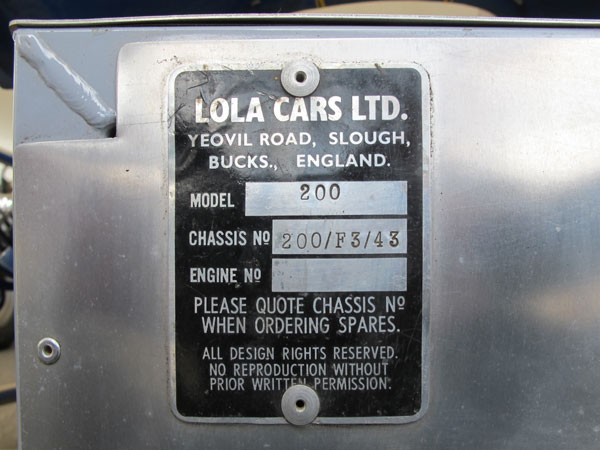
�
LOLA CARS LTD.
�
Yeovil Road, Slough, Bucks., England.
�
Model 200, Chassis No. 200/F3/43, Engine No. (blank)
�
Please quote chassis number when ordering spares.
�
All design rights reserved. No reproduction without prior written permission.
�
Kurt's Lola T200: chassis number 200/F3/43
��
Kurt Fischer has just completed his first racing season, and he's delighted with his decision�
to start with this Lola T200. Kurt bought the T200 from Marc Giroux, who purchased it in late�
1997 and has actively raced it since 1998. When I first met these two gentlemen, Kurt was�
parked just a few feet from Marc's Brabham BT29 Formula B racecar.�
�
Marc bought the T200 from Dave Sharp of Maryland who in turn had purchased it from�
Jay Galpin of Colorado who restored it in the late eighties or early nineties. Before�
that, the car's history is largely unknown but it most likely hadn't raced in years.�
�
Please support the sponsoring companies who make www.BritishRaceCar.com possible, including:
� �
 �
�
�
�
Features and Specifications
�| Engine: | �Ford Kent 1600cc with dry sump, rebuilt by Marcovicci-Wenz Engineering (MWE).�
Weber 32/36 DGAV carburetor.�
BAT throttle linkage.�
RamAir foam air filter.�
Motorcraft distributor. �
Lucas Sport "gold" ignition coil.�
Moroso Spiral Core high temperature 8mm spark plug wires.�
BAT oil pump.�
Fram HP1 oil filter.�
| �
| Cooling: | �Englewood Auto copper and brass crossflow radiator. 13-row oil cooler. | �
| Exhaust: | �Hytech Headers stainless steel tri-Y headers featuring patented anti-reversion chambers. | �
| Transaxle: | �Hewland Mk8 4-speed.�
Rubber drive donuts.�
Donut savers.�
Girling clutch master cylinder.�
Girling clutch slave cylinder. | �
| Front Susp.: | �unequal length wide-based wishbones.�
Lola proprietary fabricated steel front uprights, featuring live stub axles.�
KONI double adjustable, steel bodied shock absorbers.�
Hyperco springs.�
Anti-sway bar with three selectable stiffness settings. | �
| Rear Susp.: | �inverted lower wishbones, single top links, and twin adjustable trailing links.�
Lola proprietary cast magnesium rear uprights.�
KONI double adjustable, steel bodied shock absorbers.�
Hyperco springs.�
Anti-sway bar with five selectable stiffness settings. | �
| Brakes: | �(master) dual Girling master cylinders (5/8" front and 3/4" rear) with bias bar and Tilton remote adjuster. � (front) Girling 14LF calipers and solid rotors, � (rear) Girling 14LF calipers and solid rotors. | �
| Wheels/Tires: | �Diamond Racing Wheels 13x5.5 steel disc wheels, in white powdercoat. (Rolled-rim version.)�
Dunlop Racing "Formula Ford" tires (135/545-13 CR82 front, 165/580-13 CR82 rear). | �
| Electrical: | �compact gel-cell battery.�
Lucas starter. | �
| Instruments: | �(left to right)�
AutoMeter water temperature gauge (110-240F),�
Stack Quartz tachometer (0-8000rpm),�
AutoMeter oil pressure gauge (0-100psi). | �
| Fuel System: | �Fuel Safe 5-gallon wedge-shaped under-seat fuel cell.�
Mechanical fuel pump with push-on fittings.�
Earl's fuel filter.�
| �
| Safety Eqmt: | �OMP six point safety harness.�
Auto Pro Racing Systems 5 pound centralized fire suppression system.�
SPA Design quick release steering wheel hub on a Mountney of Britain steering wheel.�
Vitaloni mirrors.�
LED rain light.�
| �
Engine Installation
��
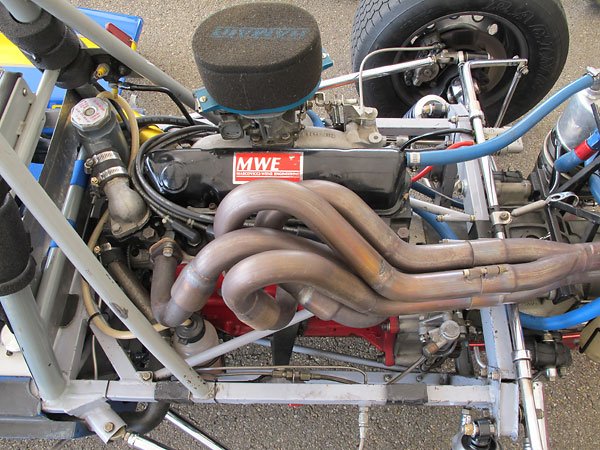
�
Ford Kent 1600cc with dry sump, rebuilt by Marcovicci-Wenz Engineering (MWE).
�
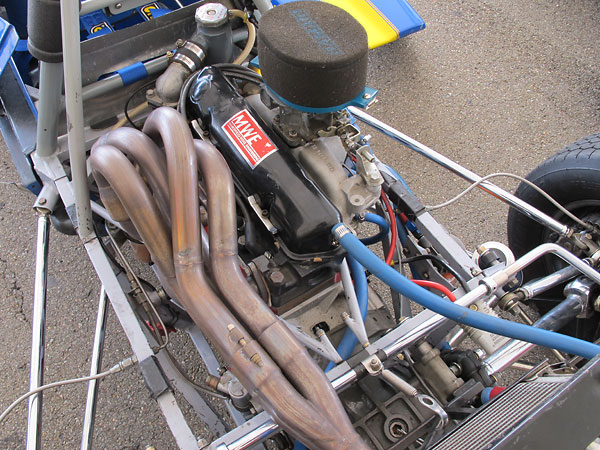
�
Hytech Headers stainless steel tri-Y headers featuring anti-reversion chambers.
�
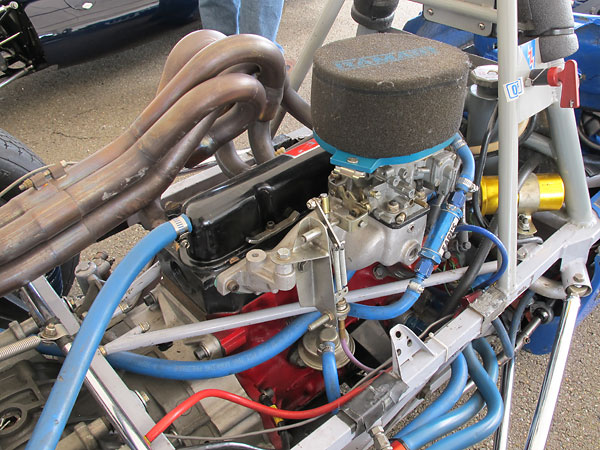
�
BAT throttle linkage.
�
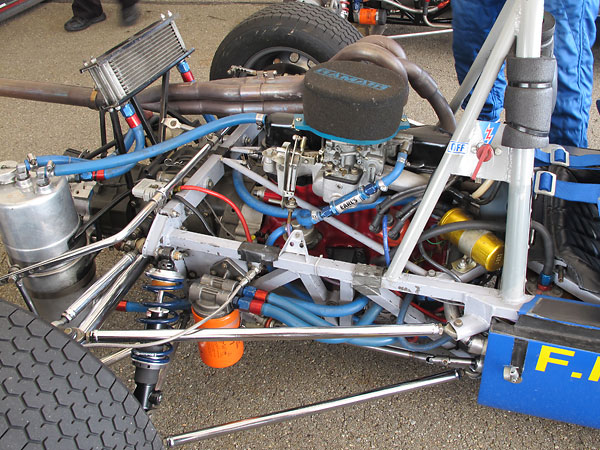
�
Motorcraft distributor. Lucas Sport "gold" ignition coil. Moroso Spiral Core spark plug wires.
�
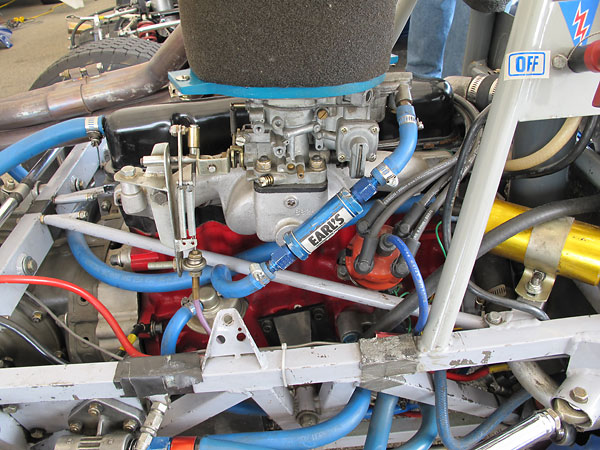
�
Weber 32/36 DGAV carburetor. Earl's fuel filter. RamAir foam air filter.
�
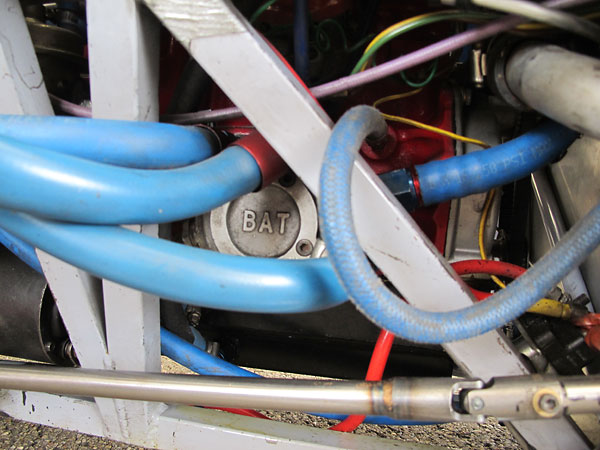
�
BAT oil pump.
�
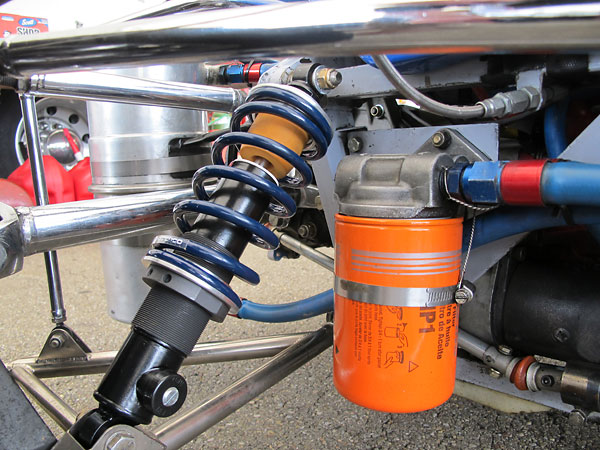
�
Fram HP1 oil filter.
�
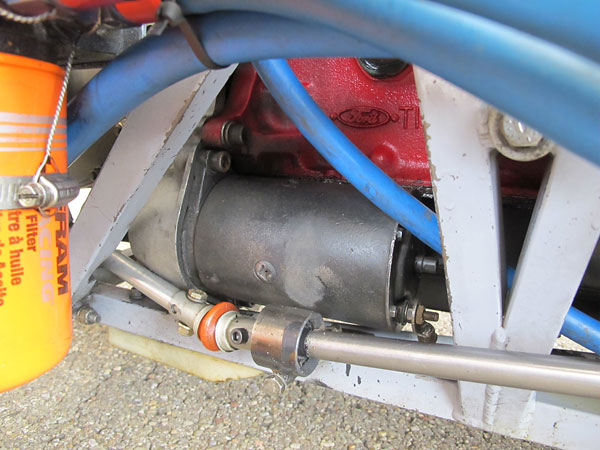
�
Lucas starter motor.
�
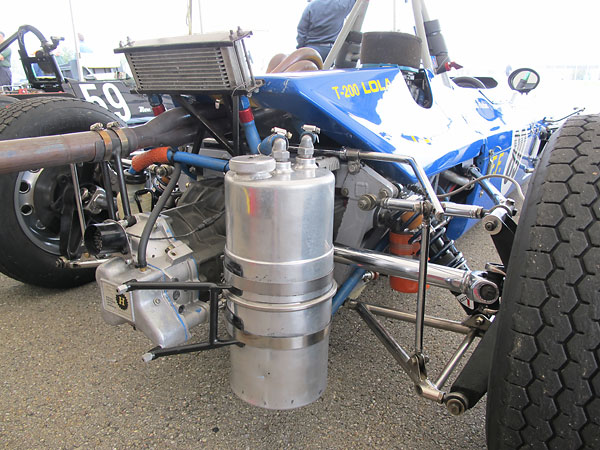
�
Engine oil reservoir.
�
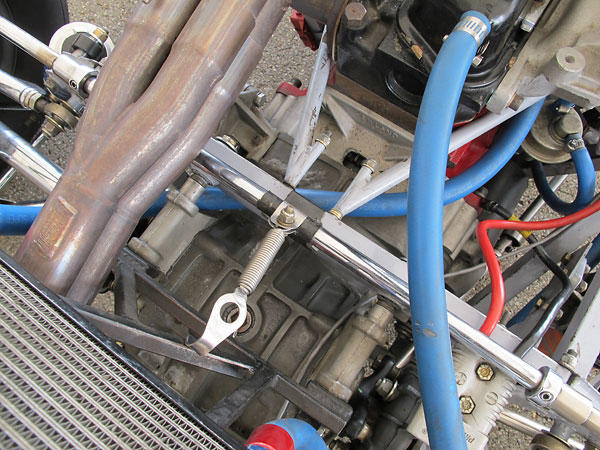
�
Tubular racecar frame designs are usually compromized across the top of the cockpit and
�
top of the engine bay. In the case of the engine bay, braces can be bolted-in to regain
�
some of the strength and stiffness lost. The Lola T200 featured two straight braces where
�
most contemporary Formula Fords featured a single Y-shaped brace.
�
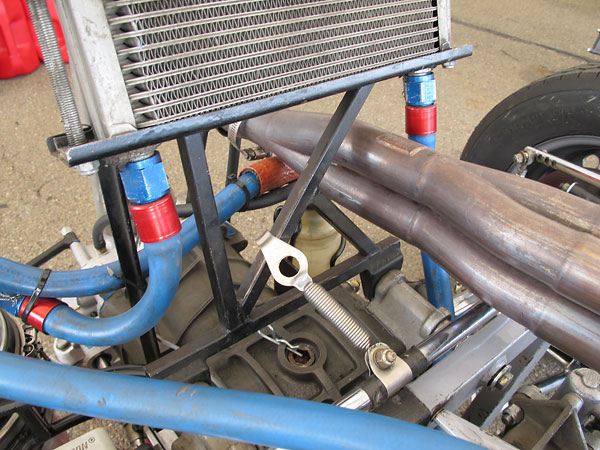
�
13-row oil cooler.
�
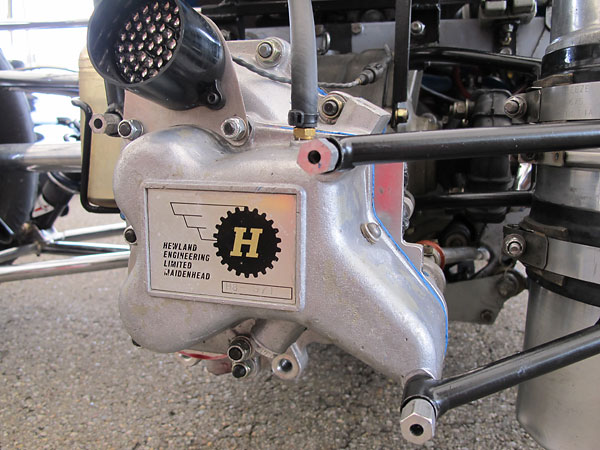
�
Hewland Engineering Limited, Maidenhead. (Serial number H8-971.)
�
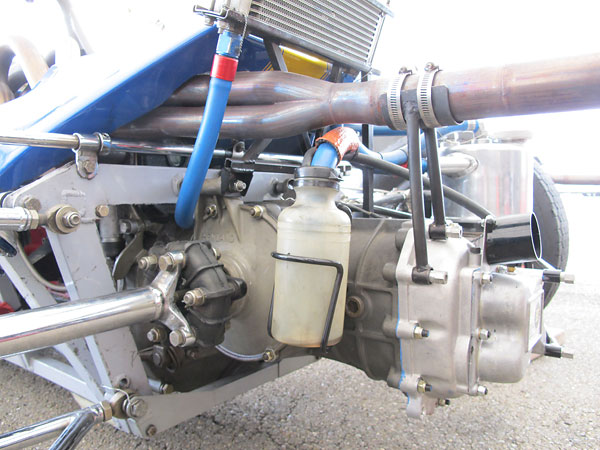
�
Rotoflex couplings.
�
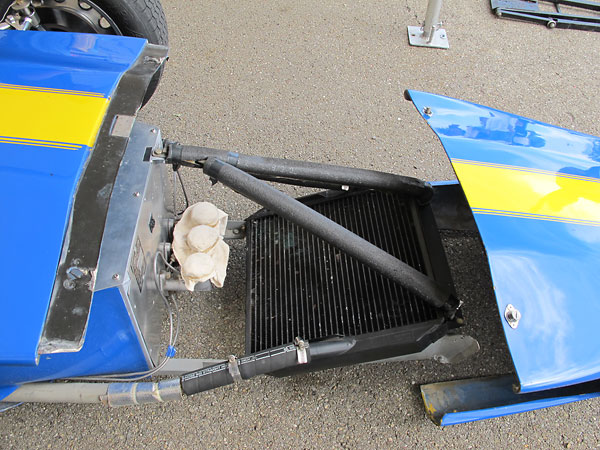
�
The original T200 design featured a one piece cowl/nose. This specially modified bodywork
�
provides better service access to hydraulics. Here, we see a copper and brass crossflow radiator.
�
(This is a replica of the original. It was crafted by Englewood Auto of Denver Colorado).
�
�
Front Suspension / Etc.
��
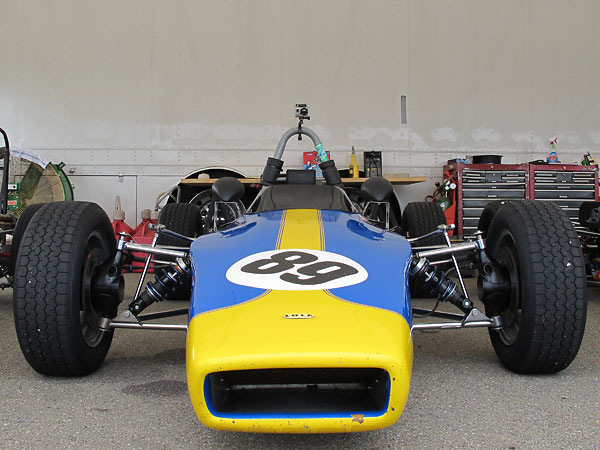
�
Unequal length wide-based dual wishbone front suspension.
�
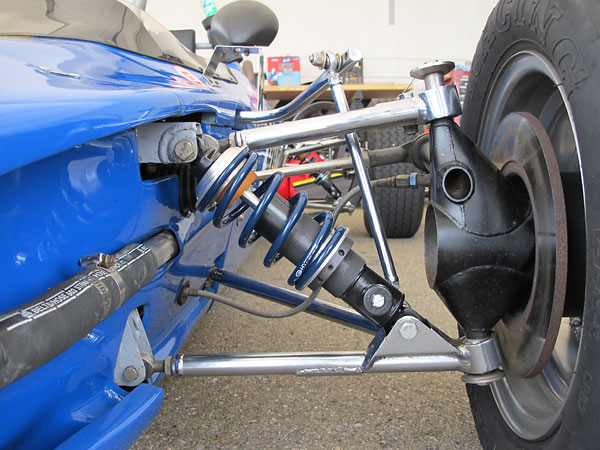
�
KONI double adjustable, steel bodied shock absorbers and Hyperco springs.
�
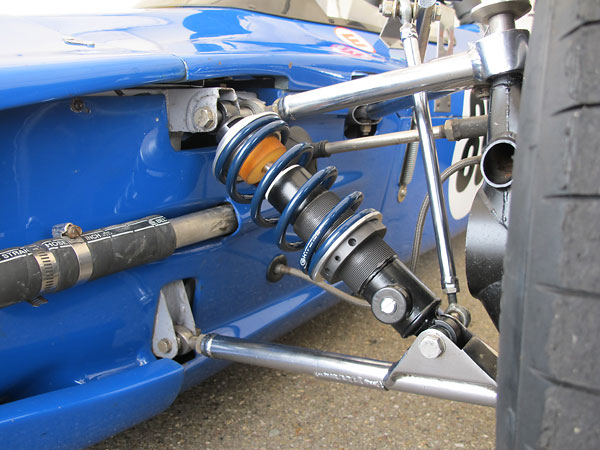
�
Lola originally shipped the car with SPAX shock absorbers.
�
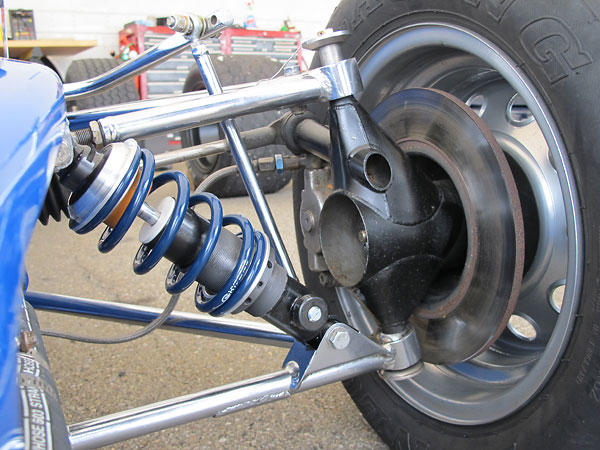
�
Lola proprietary fabricated steel front uprights featuring live stub axles.
�
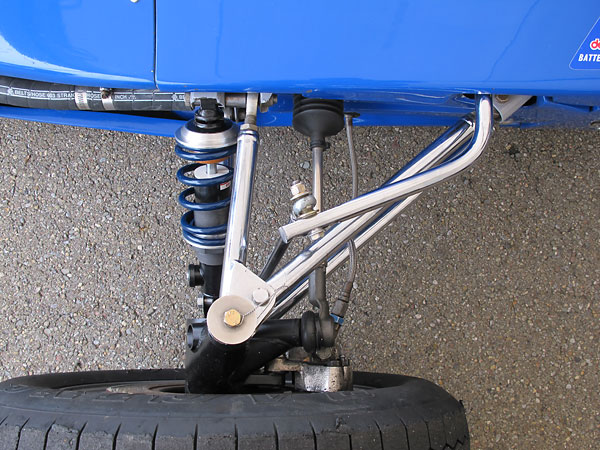
�
In an accident it's possible for the round ball of a spherical bearing to tear out of its socket.
�
Oversize washers ensure the upright won't part company from the control arm.
�
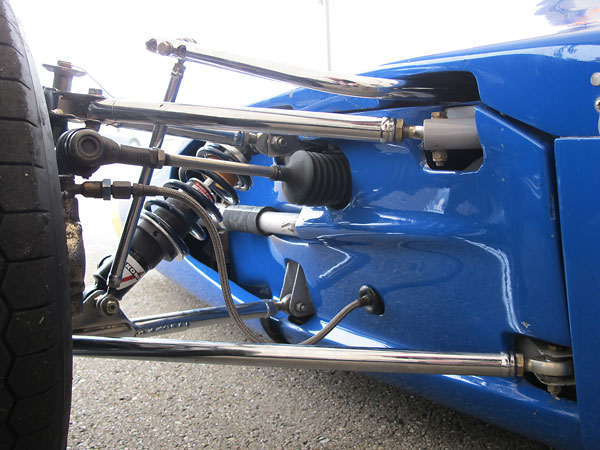
�
Anti-sway bar with three selectable stiffness settings.
�
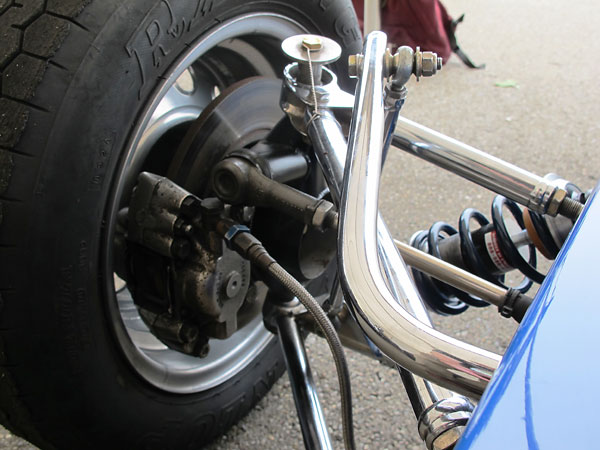
�
Girling 14LF brake calipers and Girling-supplied solid rotors. (Note: so far we've been unable
�
to determine exactly which small road car these particular brake rotors were originally made
�
for. Please contact BritishRacecar.com if you can supply this information.)
�
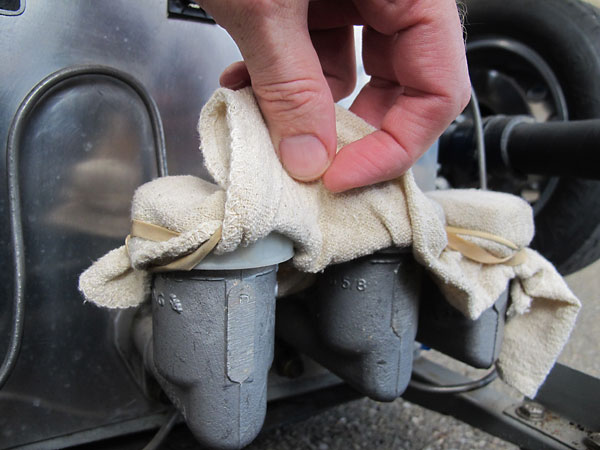
�
Girling identifies the bore diameters of their master cylinders right on the casting.
�
(Here we see 3/4" bore rear and 5/8" bore front, respectively.)
�
�
IMPORTANT ANNOUNCEMENT
�
BritishRaceCar.com will have to cut back plans for continued growth if we can't find more financial support.
�
If you like what you've found here, and you want to see more, please click here and follow the instructions.
�
Readers like you keep BritishRaceCar.com online and growing through voluntary financial contributions.
�
Rear Suspension
��
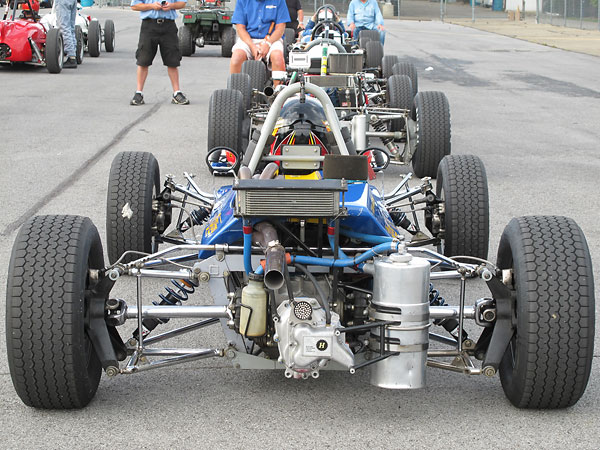
�
Inverted lower wishbones, single top links, and twin adjustable trailing links.
�
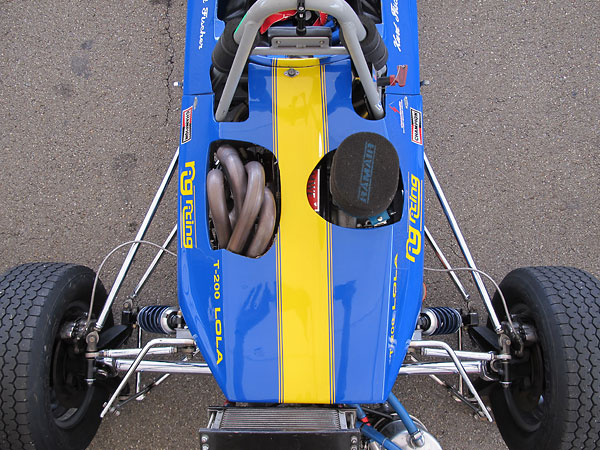
�
Both body and frame feature tough PPG two part epoxy enamel paint jobs.
�
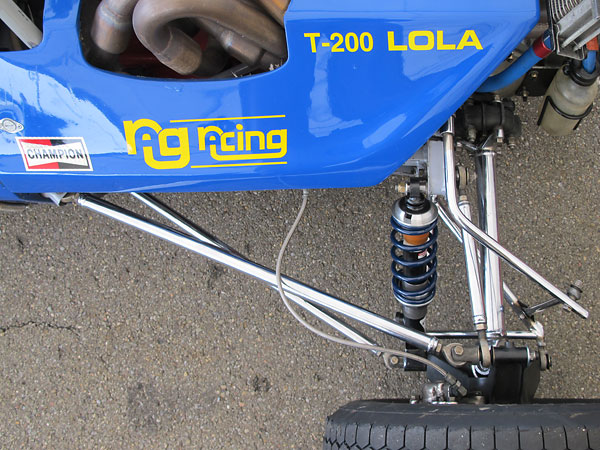
�
All suspension links, control arms, and even axle halfshafts have been nickel plated.
�
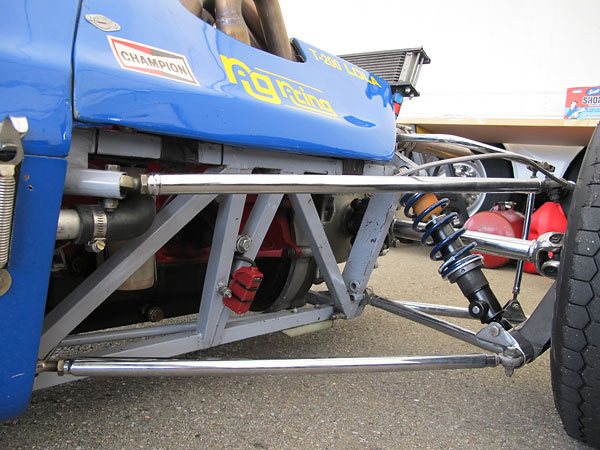
�
Square section tubing (instead of round) reflected a very pragmatic design philosophy.
�
There are many advantages, including simpler attachment of brackets and skins. Generally,
�
fabrication is cheaper because it's easier to fit, jig, and to weld joints. Theoretically, round
�
tube frames can be made much more efficiently in terms of strength to weight ratio.
�
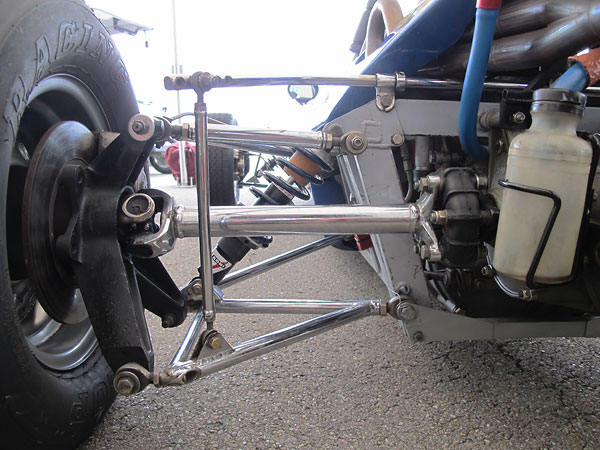
�
Lola proprietary cast magnesium rear uprights.
�
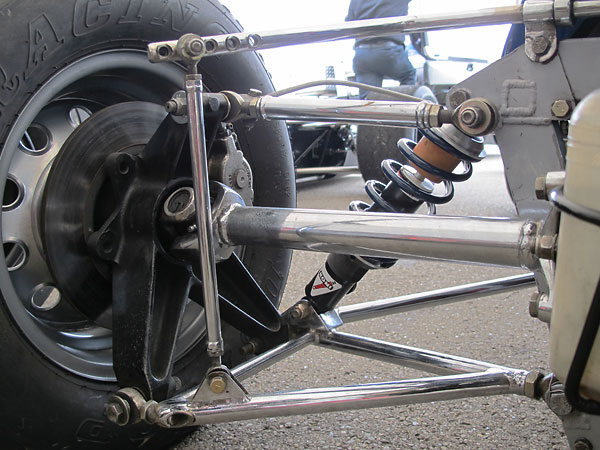
�
Anti-sway bar with five selectable stiffness settings.
�
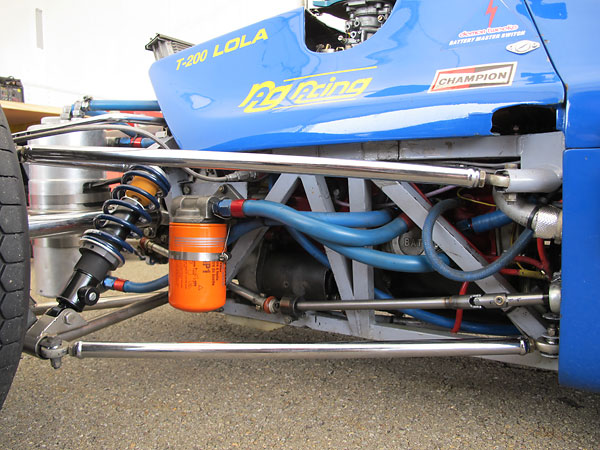
�
It costs very little more to do this smartly: double-shear joints for suspension pick-ups!
�
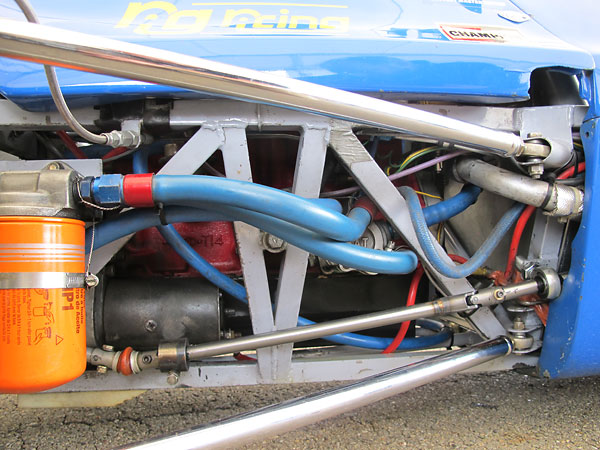
�
Lola provided two alternative connection points on the frame for each T200 lower trailing link.
�
�
Interior
��
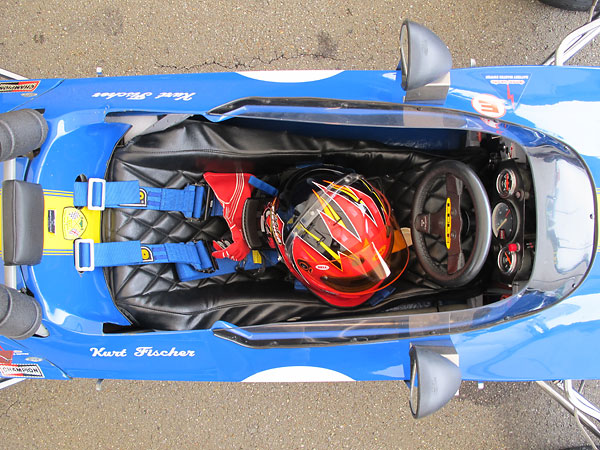
�
OMP six point safety harness.
�
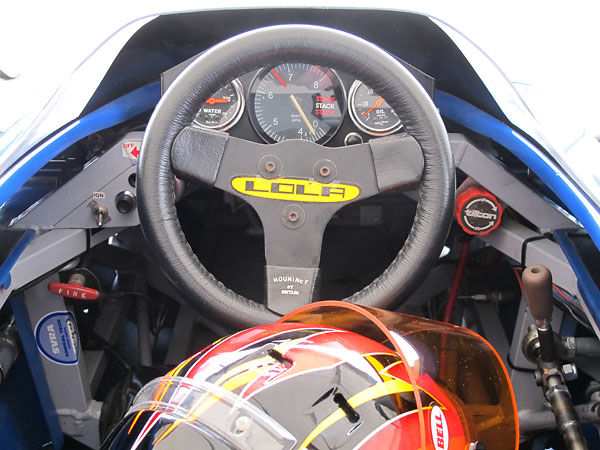
�
Mountney of Britain steering wheel.
�
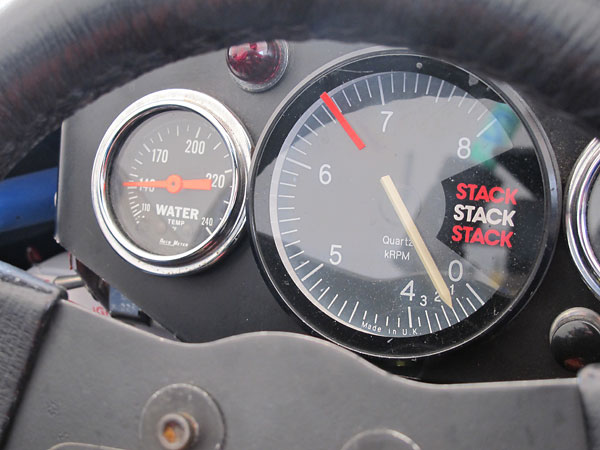
�
AutoMeter water temperature gauge (110-240F) and Stack Quartz tachometer (0-8000rpm).
�
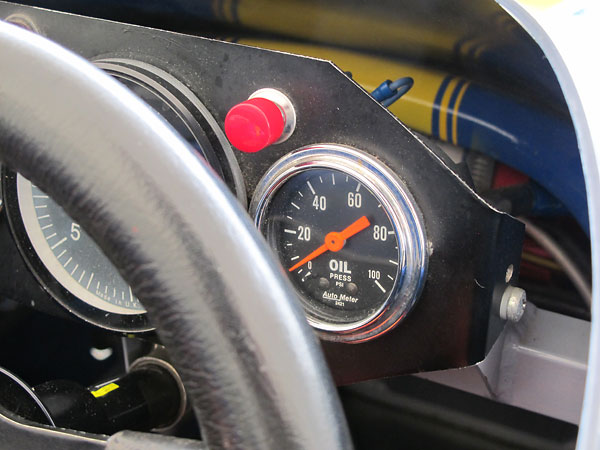
�
AutoMeter oil pressure gauge (0-100psi).
�
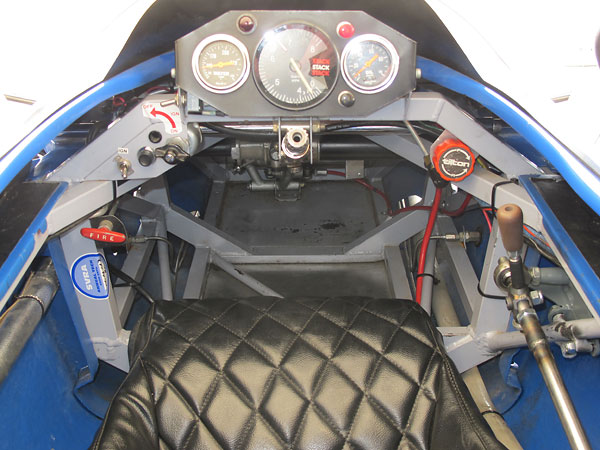
�
This is an original Lola T200 fiberglass seat, but with a new padded vinyl cover.
�
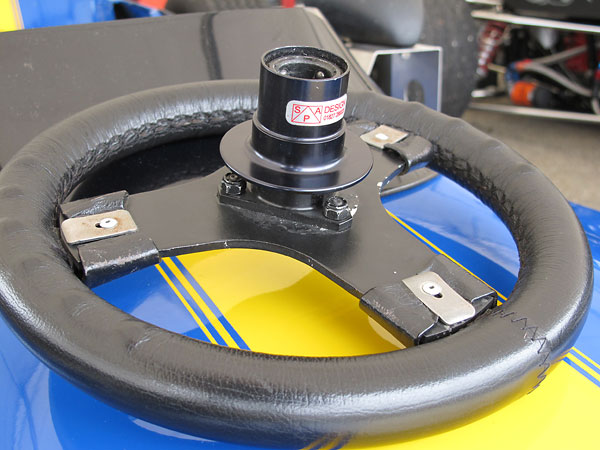
�
SPA Design quick release steering wheel hub.
�
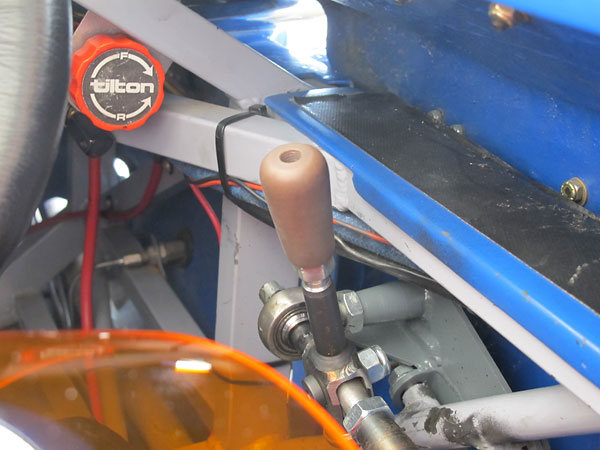
�
Gear selector. Tilton remote brake bias adjuster knob.
�
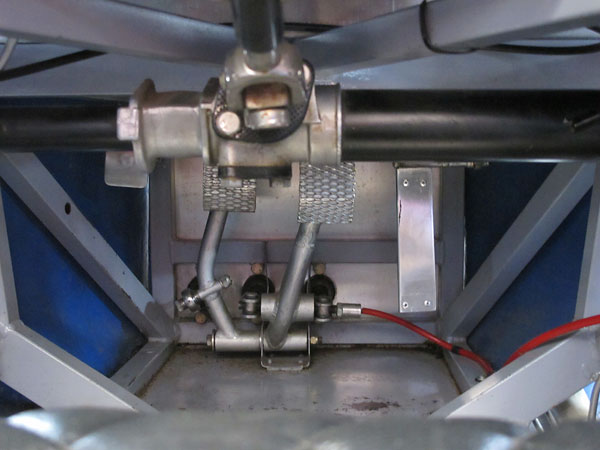
�
T200 brake pedals, clutch pedals, and pedal bracketry bear a strong family resemblance to larger
�
Lola racecars of their era such as the T190�
and T192 Formula 5000 racecars.
�
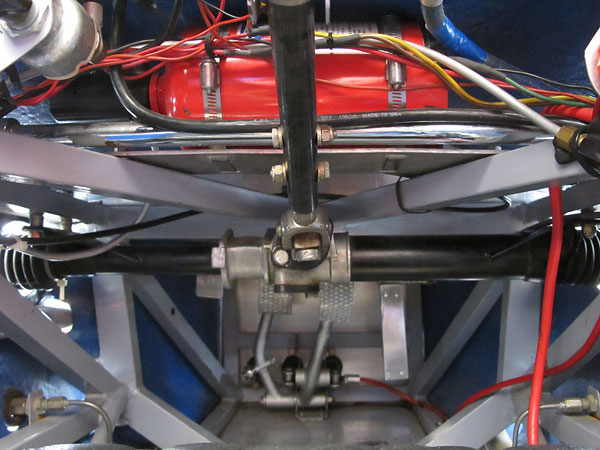
�
Extensively re-worked left-hand drive Ford Escort Mk1 steering racks were used on most
�
small Lola racecars from the T200 Formula Ford onward for about a decade.
�
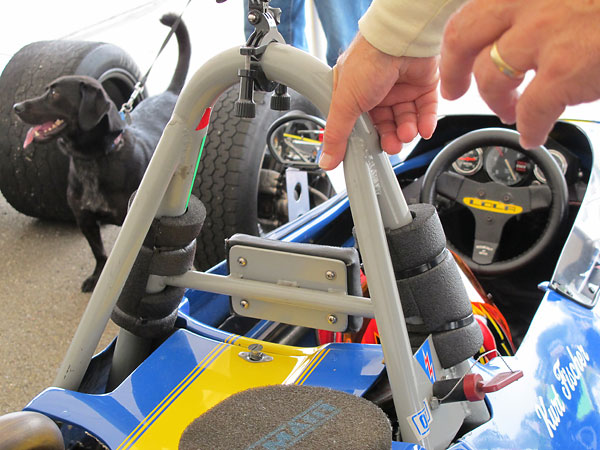
�
Since about 1986, SCCA has required forward rollhoop braces plus a second rollhoop at the instrument
�
panel. Before that, SCCA required (rearward) main hoop braces approach at an angle of no more than
�
thirty degrees from the ground plane. As shown here, the original T200 design featured two rearward
�
braces. (The T202 and T204 models featured a single detachable rearward brace from the top of their
�
rollhoop to the center of the frame crossmember, behind their engine.) That Kurt's car has never been
�
updated indicates a long period of inactivity in its racing history.
�
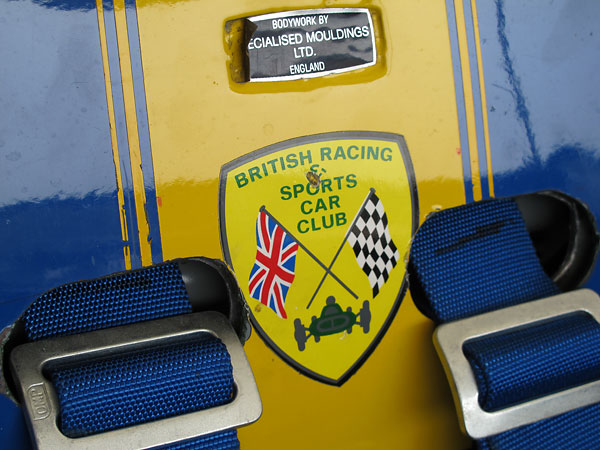
�
Bodywork by Specialized Mouldings Ltd., England.
�
British Racing & Sports Car Club
�
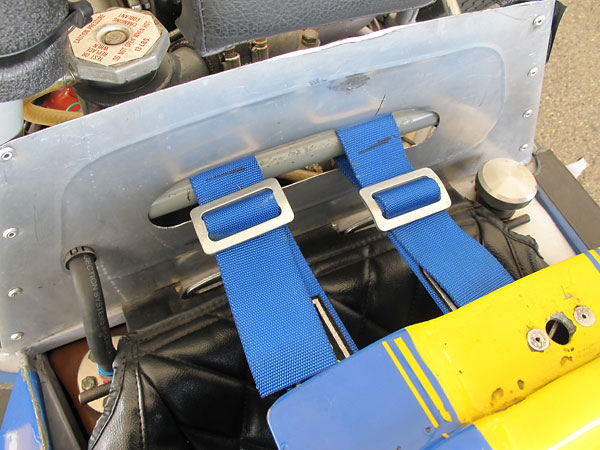
�
Marc Giroux relocated the shoulder harness connection points both higher and closer together.
�
If connection points are too low, in the event of a high speed impact the driver will be
�
pressed downward by the belts and there's a greater danger of spine compression injury.
�
Narrow spacing is required for compatibility with HANS (Head and Neck Support) devices.
�
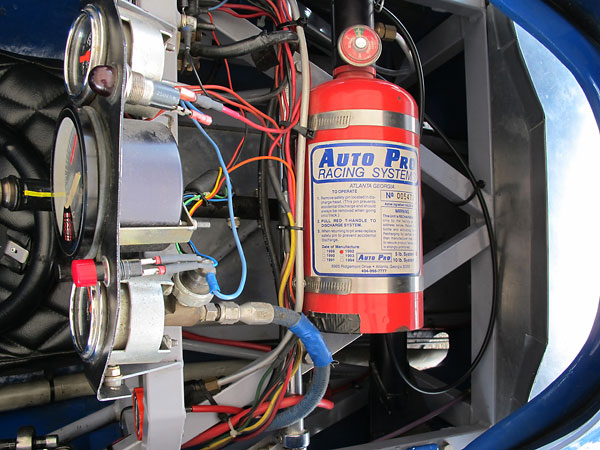
�
Auto Pro Racing Systems five pound centralized fire suppression system.
�
�
Exterior
��
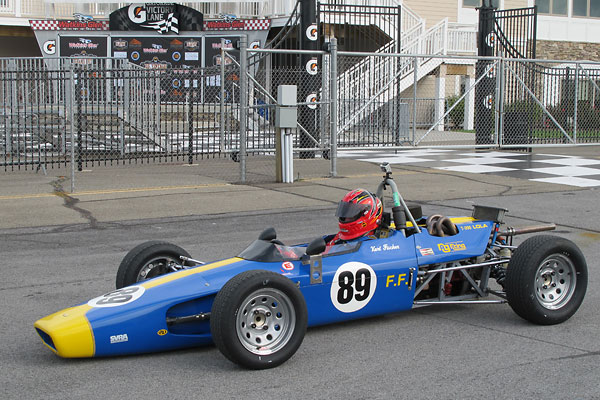
�
At the Sportscar Vintage Racing Association's 2011 US Vintage Grand Prix of Watkins Glen,
�
Kurt Fischer circled the challenging 3.4 mile circuit with a smoking hot best lap time of
�
2:14.114, which averages out to 91.266mph. Kurt's second-in-class finish is even more
�
impressive considering that he's new to the sport. No one was having more fun than Kurt!
�
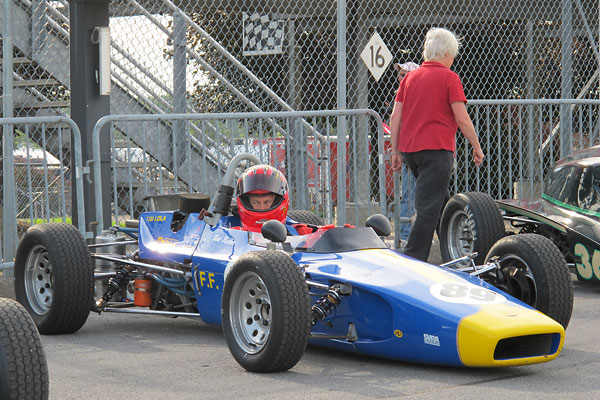
�
Neatly bridging the gap between the classic "cigar" styling�
of the sixties and the "chisel"
�
styling of the early seventies, Lolas T200 is certainly among the best looking Formula Fords.
�
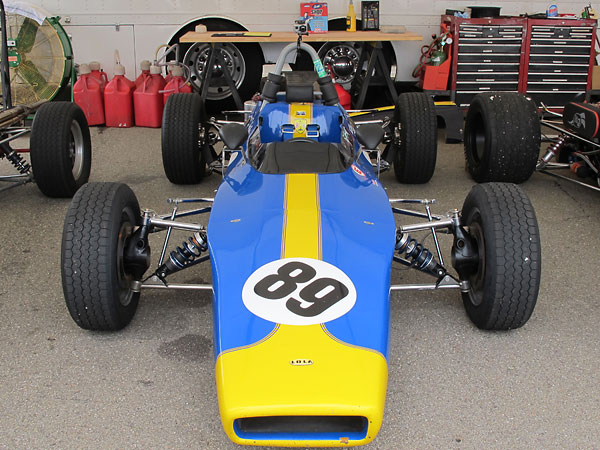
�
Compared to its contemporaries, the Lola T200 featured an uncommonly short wheelbase,
�
uncommonly wide wheel spacing (i.e. "track"), uncommonly low driver position, and
�
an uncommonly robust frame. T200's are at their best on tight and twisty racetracks.
�
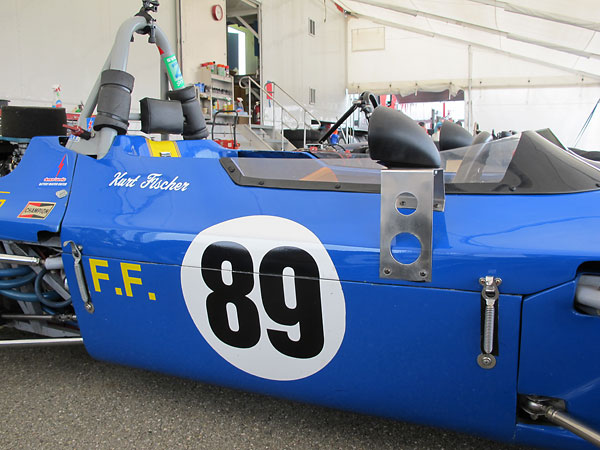
�
Vitaloni mirrors on fabricated aluminum brackets.
�
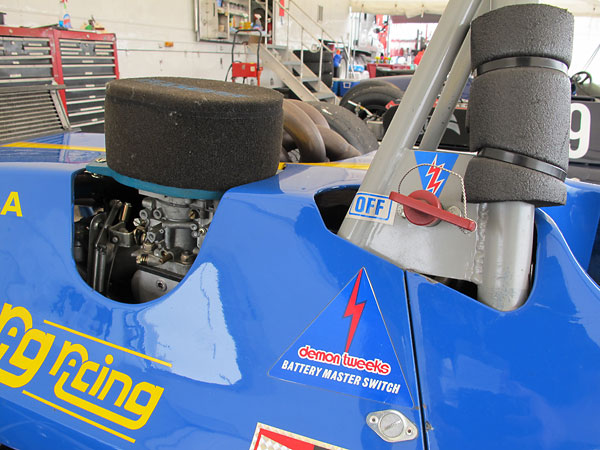
�
The battery master switch is a critical safety feature. Since the car has no charging sytem,
�
this switch shuts off the engine's ignition system. Depowering other circuits eliminates the
�
possibility of an electrical fire starting from a short circuit (e.g. from a pinched wire).
�
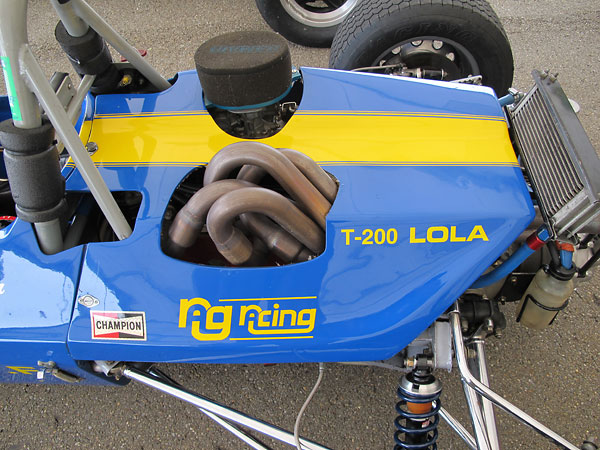
�
A great idea: incorporated make and model info into racecar livery. This is just one of many small
�
ways to make vintage racing more friendly and welcoming to new generations of enthusiasts.
�
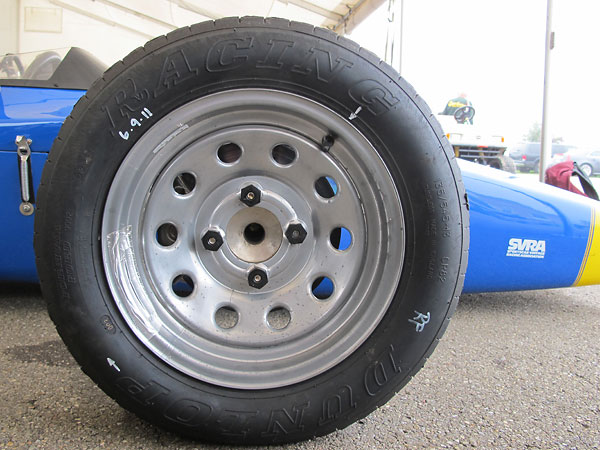
�
Diamond Racing Wheels 13x5.5 steel disc wheels. (Rolled-rim version.)
�
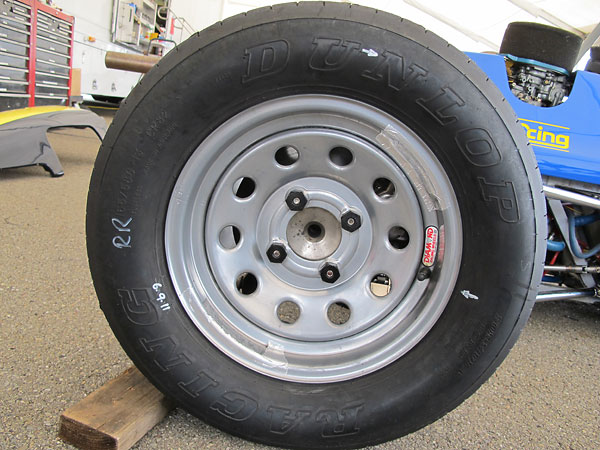
�
Dunlop Racing "Formula Ford" tires (135/545-13 CR82 front, 165/580-13 CR82 rear).
�
�
All other photos are from September 2011 when the car appeared at The US Vintage Grand �
Prix at Watkins Glen. Photos by Curtis Jacobson for BritishRaceCar.com. �
Copyright 2011. All rights reserved.
�
| If you liked this article, you'll probably also enjoy these: | �|||||
 | �
Eric Haga '70 Lola T190 | �
 | �
Kyle Kaulback '70 Lotus 61MX | �
 | �
Jim Johnson '72 March 729 | �
| You're invited to discuss anything you've seen here on The British Racecar Motorsports Forum! | �|||||
�
Notice: all the articles and almost all the photos on BritishRacecar.com are by Curtis Jacobson.
�
(Photos that aren't by Curtis are explicitly credited.) Reproduction without prior written permission is prohibited.
�
Contact us to purchase images or reproduction permission. Higher resolution images are optionally available.
�

 �
�